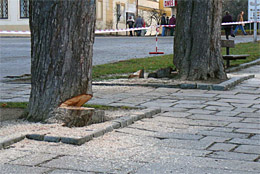
The Písek Bakalars have transformed into a relaxation zone
 |
"This is the first phase of the overall solution. It is the area of the so-called Bakaláře, where we complete the loop around the center of the city, which once led along the city walls,” said Mayor Miroslav Sládek to ČTK today. He explained that the reconstruction of the space thus continued the restoration of the ramparts and the construction of the promenade along the Otava River to the Stone Bridge in previous years.
After years of disputes between the city and opponents of the felling, some original trunks remained on site. "It is a small disappointment that it was not possible to plant the avenue completely new. It would have been for future generations, so that trees of the same age would grow evenly,” said architect Kateřina Vávrová. Together with the co-author of the project, Karel Lapka, they appreciated primarily the craftsmanship of the design.
The space, where the first Písek Latin humanist school was located in 1565, has been completed with stone benches arranged in rows. Other artistic elements recall the historical fountain or hint at the course of the original city walls.
However, some residents of Písek are not satisfied with the outcome. “It is a monument to the smallness of the Písek town hall that it is not willing to discuss public matters with citizens,” remarked project opponent Martin Zborník. He stated that green areas have decreased, and he does not consider the stone benches a fortunate solution either.
During the archaeological research of Bakaláře, which accompanied the reconstruction of the space last year and this year, experts examined the foundations of the Renaissance school. They discovered two wells, five cremation graves from the 13th to 12th centuries BC, and three stone chambers from the Middle Bronze Age, approximately from the 15th century BC. These represent an extraordinary find, as their uncovering in the area of the city's historical core is unusual in Central Europe. The discovered historical artifacts will also become an adornment of this location.
The English translation is powered by AI tool. Switch to Czech to view the original text source.
2 comments
add comment
Subject
Author
Date
fotky
tea
15.05.09 12:14
Fotky třeba zde:
Berny
21.05.09 01:16
show all comments







